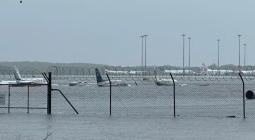On the brink: California’s luxe clifftop mansions in peril after record rain
Homeowners in wealthy towns watching anxiously in face of heavy storms that have caused flash floods and coastal erosion
The torrents of water coming from the sky are having ripple effects on the cliffs that hold up some of California’s most expensive real estate. In the first two months of the year, nearly 18in of rain has fallen in the southern California area, about 8in above normal to date – and more is on the way this week.
The California governor, Gavin Newsom, declared a state of emergency in eight counties covering more than 20 million people, and flash-flood warnings were issued for parts of Los Angeles, Santa Barbara and San Luis Obispo counties.
In wealthy coastal cities such as San Clemente and Dana Point, homeowners watch hour by hour as multimillion-dollar houses on cliffs dangle above landslides brought on by the storms. Homeowner Alan Ashavi told Reuters he was checking on his property every day after his swimming pool was on the brink of collapse.
Money to protect properties in California from the onslaught of the climate crisis – stronger storms, higher seas and landslides – will eventually come from the state. The cost of publicly funded disaster relief programs and state-subsidized insurance payouts will be assumed by everyone, including those who have no part in luxury homes with a view. The majority of Latino and Black households in California don’t own their homes.
The Los Angeles Times estimates that $150bn in California property might be affected by coastal flooding and erosion by 2100 – meaning a hefty price tag that the state will probably protect, through stabilizing insurance premiums and paying for the cost of rebuilding following disasters.
Some cities are encouraging a strategy of so-called “managed retreat” – simply moving back from the edge of the sea in the face of a changing shoreline and environment.
But in others, such as Pacifica, residents were forced to move facilities in an unplanned way in 2016 when a dozen clifftop residences had to be demolished for being unsafe. In the end, the cost was $16m – and the public got stuck with the price tag.
Insurance for homes in wildfire zones is already an issue. In 2023, seven of the 12 insurance groups operating in California – together, responsible for about 85% of the market – have pulled back from taking on new residential and commercial properties due to wildfire risk. That leaves homeowners with the option of buying a pricey Fair plan from the state directly, as a last resort. It’s still debated how much risk a homeowner should take on, when living in a dangerous place.
And it will probably be everywhere as the climate crisis picks up speed, as Newsom pointed out in an interview with Politico: “America’s coming attraction in terms of impacts of climate.” Last fall, there was a legislative plan to make a fix, but it died in closed-door sessions.
Even at the federal level, money is starting to be tighter: Joe Biden had to ask Congress for additional money to pay into the Disaster Relief Fund last fall, after it ran out of cash for recovery from catastrophes.
One expert predicts a 100-meter destruction of sea cliffs in the future, which puts many multimillion-dollar homes at risk in the coming years.
“We have these atmospheric rivers coming off the oceans, drops the rain here on these hills and then the hills start eroding as well,” Kathleen Treseder, a climate change professor at the University of California at Irvine, told Reuters.
“And so not only do we have this erosion right here from the waves, but we also have erosion up inland caused by the rainfall.”
Cover photo: An aerial view in Dana Point. Photograph: Mario Tama/Getty Images






